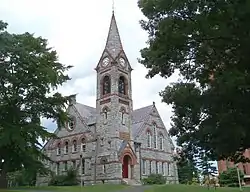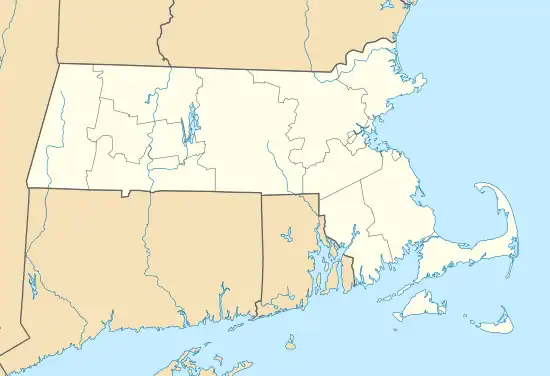Old Chapel (Amherst, Massachusetts)
Old Chapel, formerly known as the Old Chapel Library is a former library on the campus of the University of Massachusetts Amherst that is on the National Register of Historic Places.
Old Chapel | |
 | |
 Location of Old Chapel within Massachusetts | |
| Location | Amherst, Massachusetts |
|---|---|
| Coordinates | 42°23′20.24″N 72°31′40.70″W |
| Built | 1884-1887 |
| Architect | Stephen C. Earle, Worcester |
| Architectural style | Richardsonian Romanesque |
| NRHP reference No. | 15000211 |
| Added to NRHP | May 11, 2015 |
History
Old Chapel was originally constructed in Richardson Romanesque-style between 1884 and 1887 at a cost of $25,000 (equivalent to $814,259 in today's dollars),[1] to serve as a library, museum, and assembly hall.[2] The building was designed by Worcester architect Stephen C. Earle, and is a roughly square stone structure with a tower at its southeast corner. It is made primarily of granite, with sandstone trim and a slate roof. The tower features an open belfry with rounded arches, above which are gabled peaks with clock faces, and a diagonally set four-sided steeple at the top.[3]
According to the school, John F. Kennedy supposedly spoke at the Chapel during his 1952 U.S. Senate campaign,[4] although this has never been confirmed.
The chapel's original bell, "Old Aggie," was added in 1892, but has since been replaced by 44 carillon bells. Although the tower underwent a $1.65 million renovation in 1999, Old Chapel has been uninhabited since 1996, when the University of Massachusetts Minuteman Marching Band moved out due to unsafe conditions within the structure. Since then, a movement amongst alumni was created to further renovate the interior of the building so that the structure could be used again.[2]
Restoration of Old Chapel began in 2015 after a 2013 campaign by Chancellor Kumble R. Subbaswamy to restore and repurpose the interior of the structure.[5] This included a nomination by Preserve UMass to place the structure on the National Register of Historic Places, which occurred on May 11, 2015.[6]
References
- 1634–1699: McCusker, J. J. (1997). How Much Is That in Real Money? A Historical Price Index for Use as a Deflator of Money Values in the Economy of the United States: Addenda et Corrigenda (PDF). American Antiquarian Society. 1700–1799: McCusker, J. J. (1992). How Much Is That in Real Money? A Historical Price Index for Use as a Deflator of Money Values in the Economy of the United States (PDF). American Antiquarian Society. 1800–present: Federal Reserve Bank of Minneapolis. "Consumer Price Index (estimate) 1800–". Retrieved May 28, 2023.
- Phillis, Michael (4 December 2009). "Old Chapel UMass' lone national registry of historic places qualifier". The Massachusetts Daily Collegian. Retrieved 5 June 2015.
- "MACRIS inventory record for UMass Department of Music". Commonwealth of Massachusetts. Retrieved 2015-05-26.
- "Welcome to the (unofficial) University of Massachusetts at Amherst Old Chapel Library Homepage". University of Massachusetts Amherst. 2000. Retrieved 5 June 2015.
- "Restore Old Chapel". University of Massachusetts Amherst. Retrieved 5 June 2015.
- Lederman, Diane (4 June 2015). "Old Chapel at UMass now on National Register of Historic Places". The Republican. Retrieved 5 June 2015.
